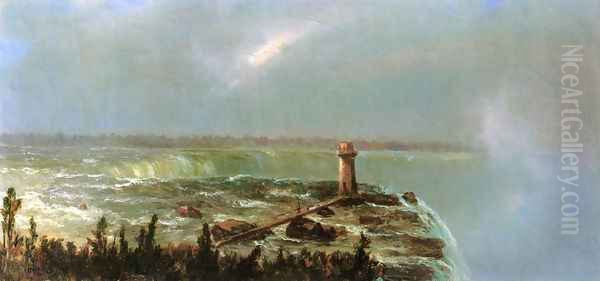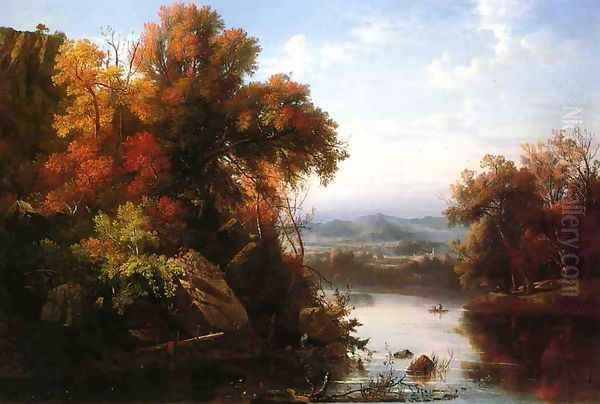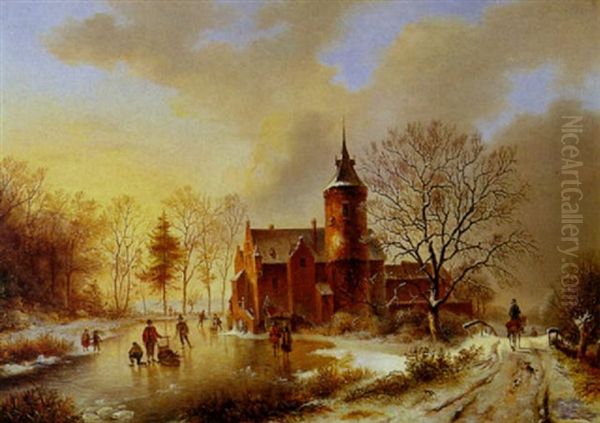Régis François Gignoux stands as a significant, if sometimes overlooked, figure in the annals of 19th-century art, a painter whose career gracefully bridged the artistic traditions of France and the burgeoning landscape school of America. Born in France and trained in its prestigious academies, Gignoux brought a European sensibility to the wild, untamed vistas of the New World. He became particularly renowned for his evocative winter scenes, capturing the crisp air, crystalline light, and hushed beauty of the snow-covered American Northeast with a finesse that few contemporaries could match. As an active member of the Hudson River School, a respected teacher, and a leader in artistic organizations, Gignoux left an indelible mark on the American art scene before eventually returning to his native France.
Early Life and Artistic Formation in France
Régis François Gignoux was born in Lyon, France, in 1816. His early artistic inclinations led him to seek formal training, a path that eventually took him to Paris, the epicenter of the European art world. He enrolled in the prestigious École des Beaux-Arts, the leading art institution in France, known for its rigorous academic curriculum that emphasized drawing, classical principles, and the study of Old Masters. This foundational training would instill in Gignoux a lifelong attention to detail and compositional structure, even as he later embraced the more romantic and naturalistic trends in landscape painting.

During his time at the École des Beaux-Arts, Gignoux had the distinct privilege of studying under Hippolyte Paul Delaroche (often referred to simply as Paul Delaroche). Delaroche was one of the most celebrated historical painters of his era, renowned for his meticulously rendered and dramatically charged scenes from French and English history. While Delaroche himself was not primarily a landscape painter, his emphasis on precise draughtsmanship, careful observation, and the effective telling of a story through visual means undoubtedly influenced Gignoux. It was Delaroche, according to art historical accounts, who recognized Gignoux's burgeoning talent for landscape and encouraged him to pursue this genre, a pivotal piece of advice that would shape the young artist's entire career. The academic environment, though focused on historical and figure painting, provided Gignoux with the technical skills that would later allow him to capture the subtleties of nature with such conviction.
A New World: Gignoux's Emigration to America
In 1840, at the age of 24, Régis François Gignoux made the momentous decision to emigrate to the United States. This was a period of significant European migration to America, driven by various economic, social, and political factors. For an artist, America offered the allure of new, dramatic landscapes largely untouched by extensive human development, a stark contrast to the more cultivated and historically layered scenery of Europe. Gignoux settled in Brooklyn, New York, which was then a rapidly growing city and an increasingly important cultural center in its own right, distinct from but closely connected to Manhattan.
Upon his arrival, Gignoux quickly set about establishing himself within the American art community. He opened a studio and began to paint the landscapes of his adopted country. His European training and evident skill soon garnered attention. The American art scene at this time was vibrant and expanding, with a growing public interest in art and an increasing number of patrons willing to support local artists. Landscape painting, in particular, was on the ascent, resonating with a nationalistic pride in the unique beauty and grandeur of the American continent. Gignoux, with his refined technique and fresh perspective, found a receptive audience for his work.
He became an active participant in New York's artistic life. In 1844, he was elected an associate member of the prestigious National Academy of Design in New York, a key institution for artists in America, and he achieved full academician status in 1851. His involvement extended to the burgeoning art scene in Brooklyn, where he played a foundational role in establishing the Brooklyn Art Association, serving as its first president. These affiliations underscore his rapid integration and respected standing within the American artistic fraternity.
The Hudson River School and Gignoux's Unique Contribution

Régis François Gignoux is most closely associated with the Hudson River School, America's first true school of landscape painting. This group of artists, flourishing from roughly the 1820s to the 1870s, drew inspiration from the landscapes of the Hudson River Valley, the Catskill Mountains, the White Mountains of New Hampshire, and other scenic areas of the Northeast, eventually extending their gaze to the American West and even South America. Key figures who defined the early phases of this movement included Thomas Cole, considered its founder, and Asher B. Durand, who became a leading figure after Cole's death and advocated for direct study from nature.
While Gignoux shared many of the Hudson River School's core tenets – a deep appreciation for nature, a desire to capture its specific details and atmospheric effects, and a tendency towards romantic or sublime interpretations – his European background gave his work a distinct flavor. His paintings often exhibited a polish and a sophisticated handling of light and texture that reflected his academic training. He was less inclined towards the overt moralizing or allegorical content found in some of Thomas Cole's works, focusing instead on the faithful yet poetic depiction of the scene before him.
Gignoux's most significant and unique contribution to the Hudson River School, and indeed to American landscape painting of the era, was his mastery of winter scenes. While many of his contemporaries, such as Jasper Francis Cropsey or Sanford Robinson Gifford, were celebrated for their autumnal landscapes ablaze with color, or their hazy, light-filled summer views, Gignoux made the snowy landscape his specialty. He possessed an uncanny ability to render the varied textures of snow – from crisp, freshly fallen powder to compacted, icy surfaces – and to capture the subtle gradations of light and color in a winter sky. His snow scenes were not merely topographical records but evocative portrayals of winter's quiet majesty, its stark beauty, and the play of cool, clear light.
Artistic Style: The Poetry of Light and Detail
Gignoux's artistic style was characterized by a meticulous attention to detail combined with a sensitive rendering of atmospheric conditions. His French academic training under Delaroche instilled in him a strong foundation in drawing and composition, which is evident in the careful construction of his landscapes. However, he moved beyond mere academicism to embrace the romantic naturalism prevalent in the Hudson River School. His works often convey a sense of tranquility and a deep reverence for the natural world.

A hallmark of Gignoux's style was his exceptional ability to depict light. Whether it was the soft, diffused light of an overcast winter day, the sharp, crystalline light reflecting off snow and ice, or the warm glow of an "Indian Summer" afternoon, Gignoux captured these effects with remarkable subtlety and accuracy. He understood how light interacts with different surfaces, how it defines form, and how it creates mood. This sensitivity to light and atmosphere lent his paintings a luminous quality that was highly admired.
His brushwork was generally refined and controlled, allowing for a high degree of detail without becoming overly photographic or fussy. He could render the intricate branching of trees, the texture of rocks, and the delicate forms of ice with precision, yet his paintings always maintained a sense of painterly cohesion. While he shared the Hudson River School's commitment to "truth to nature," his interpretation was often imbued with a gentle lyricism. His landscapes, particularly his winter scenes, often evoke a feeling of stillness and peace, inviting quiet contemplation.
Masterpieces and Representative Works
Throughout his prolific career in America, Régis François Gignoux produced a significant body of work, with several paintings standing out as particularly representative of his style and thematic concerns. His depictions of iconic American landmarks and his signature winter landscapes cemented his reputation.
One of his most famous subjects was Niagara Falls. Like many artists of his time, including Frederic Edwin Church and Albert Bierstadt, Gignoux was drawn to the sublime power and grandeur of this natural wonder. His interpretations of Niagara, often depicted in winter, showcased his skill in rendering the massive ice formations, the churning, misty water, and the dramatic interplay of light on the frozen spectacle. These paintings captured both the awe-inspiring scale of the falls and the unique beauty of its winter guise.
Winter Scene in New Jersey (and similar titles depicting specific locales) exemplifies his specialization. These works often feature snow-covered fields, frozen streams or ponds, and trees delicately laden with snow or ice. Figures, if present, are usually small, emphasizing the dominance of nature and often engaged in winter activities like skating or sleighing, adding a touch of human warmth and narrative to the otherwise serene landscape. The play of cool blues, grays, and whites, accented by the warmer tones of tree bark or a distant sunset, is characteristic of these pieces.
Gignoux also painted scenes of other seasons, demonstrating his versatility. Indian Summer is a title associated with works that capture the hazy, golden light and rich, muted colors of late autumn in the American Northeast. These paintings evoke a sense of warmth and nostalgia, a fleeting moment of beauty before the onset of winter.
His depictions of the Catskill Mountains and other regions of the Hudson River Valley place him firmly within the mainstream of the Hudson River School. These works would have featured the rolling hills, dense forests, and picturesque waterways that so captivated his American contemporaries. Furthermore, a work like Bernese Alps by Sunrise indicates that he also drew upon European scenery, perhaps from memory, sketches, or travels, showcasing his ability to render majestic mountain scenery with dramatic lighting effects, a theme popular with Romantic painters on both sides of the Atlantic. His works are held in important collections, including the Metropolitan Museum of Art in New York and the art collections of the U.S. Capitol.
A Respected Teacher and Colleague in the American Art World
Beyond his own artistic production, Régis François Gignoux played an active role in the American art community as a teacher and colleague. His studio in New York, and later in the famed Tenth Street Studio Building (which also housed artists like Church, Bierstadt, and Kensett), became a place where younger artists could seek guidance. Gignoux's European training and his success in America made him an attractive mentor.
Perhaps his most notable student was George Inness. Inness, who would go on to become one of America's most innovative and celebrated landscape painters, studied briefly with Gignoux around 1843-1844. While Inness's mature style, characterized by Tonalism and influences from the Barbizon School (such as Jean-Baptiste-Camille Corot and Théodore Rousseau), diverged significantly from Gignoux's more detailed Hudson River School approach, the early training likely provided Inness with valuable foundational skills. Gignoux would have exposed Inness to European artistic conventions and a disciplined approach to landscape painting, which Inness later synthesized with his own deeply personal and spiritual vision of nature.
Gignoux maintained collegial relationships with many leading artists of the day. He participated in sketching expeditions, a common practice among Hudson River School painters who believed in direct observation of nature. Records suggest he undertook such trips with prominent figures like Frederic Edwin Church and John Frederick Kensett. These excursions were vital for gathering sketches and studies that would later be developed into finished paintings in the studio. Such interactions fostered a sense of community and allowed for the exchange of ideas and techniques among artists. His leadership roles, as the first president of the Brooklyn Art Association and as a full member of the National Academy of Design, further attest to the respect he commanded among his peers. He was not an isolated figure but an integral part of the artistic fabric of mid-19th century New York. Other contemporaries whose paths he likely crossed or whose work he would have known include Worthington Whittredge, another painter who spent time studying in Europe and became known for his detailed woodland interiors, and Sanford Robinson Gifford, celebrated for his luminist landscapes.
Later Years and Return to France
Despite nearly three decades of success and integration into the American art world, Régis François Gignoux made the decision to return to his native France in 1870. The reasons for his departure are not extensively documented but could have been varied, including family considerations, a desire to reconnect with his European roots, or changes in the American art scene as new artistic trends began to emerge. The Franco-Prussian War, which began in July 1870, might also have influenced his timing or decision, perhaps creating a pull towards his homeland during a period of national crisis, or conversely, making the return more complex.
Upon his return, Gignoux settled in Paris and continued to paint. While his American period is generally considered the most significant phase of his career, he remained an active artist in France. He would have brought with him a wealth of experience and a unique perspective shaped by his years depicting the American landscape. It is likely he continued to paint landscapes, perhaps revisiting European scenes or even creating new compositions based on his American sketches and memories.
Régis François Gignoux passed away in Paris in 1882, at the age of 66. He left behind a legacy as a skilled and sensitive interpreter of the natural world, an artist who successfully melded European academic training with the spirit of American landscape painting.
Legacy and Enduring Appeal
Régis François Gignoux's legacy is multifaceted. He is remembered primarily as one of the key figures of the Hudson River School, distinguished by his exceptional ability to capture the nuanced beauty of winter. His snowscapes remain highly prized for their technical skill, their atmospheric depth, and their poetic sensibility. They offered a unique perspective within a movement often celebrated for its autumnal glories or summer pastorals. He demonstrated that the American winter, often perceived as harsh or desolate, possessed its own profound and captivating charm.
As an immigrant artist, Gignoux also represents the rich cross-cultural exchanges that characterized the 19th-century art world. He brought European techniques and artistic sensibilities to America, contributing to the development of its nascent art scene, while simultaneously being inspired and transformed by the landscapes of his adopted country. His success underscores the opportunities America offered to talented individuals from abroad.
His role as a teacher, particularly his mentorship of George Inness, highlights his influence on the next generation of American painters. Even if his students ultimately pursued different artistic paths, the foundational instruction Gignoux provided was an important stepping stone. Furthermore, his active participation in institutions like the National Academy of Design and the Brooklyn Art Association helped to build the infrastructure that supported artistic growth in America.
Today, Gignoux's paintings are held in numerous public and private collections, including major institutions like the Metropolitan Museum of Art, the Brooklyn Museum, the New-York Historical Society, and the White House. His works continue to be admired for their beauty, their technical mastery, and their evocative portrayal of 19th-century American landscapes, particularly those serene, snow-covered vistas that became his signature. He remains a testament to the enduring power of landscape painting to capture not just the appearance of a place, but also its spirit.
Conclusion
Régis François Gignoux carved a distinctive niche for himself in the competitive art world of the 19th century. From his academic training in France under the tutelage of Paul Delaroche to his celebrated career in America as a prominent member of the Hudson River School, Gignoux consistently demonstrated a refined artistic vision and exceptional technical skill. His specialization in winter landscapes set him apart, allowing him to explore the subtle beauties of a season often overlooked by his contemporaries. Through his luminous and meticulously rendered paintings, his influential teaching, and his contributions to artistic organizations, Gignoux enriched the cultural landscape of America, leaving behind a body of work that continues to resonate with viewers for its tranquil beauty and its heartfelt appreciation of the natural world.